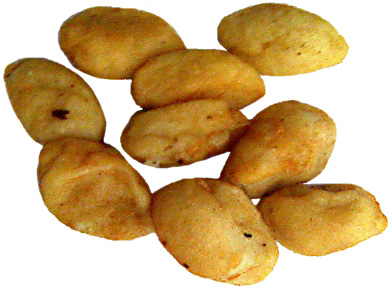...Best of Sicily presents... Best of Sicily Magazine. ... Dedicated to Sicilian art, culture, history, people, places and all things Sicilian. |
by Francesca Lombardo | ||
Magazine Index Best of Sicily Arts & Culture Fashion Food & Wine History & Society About Us Travel Faqs Contact Map of Sicily |
Like sfincione, the rather esoteric spleen sandwich and stigghiola, crocché are "street food." Arancine (rice balls) enjoy a slightly loftier place in the Sicilian culinary hierarchy and are usually served in restaurants. Unfortunately, the humble crocché usually served commercially in Sicily, whether in restaurants or by street vendors, is a pale imitation of the real deal. What you are often served in restaurants are actually little more than fried lumps of mashed potatoes. The real thing is a whole other story. Real crocché are made with mashed potatoes (the main ingredient), fresh eggs, sharp grated Italian cheese (Sicilian caciocavallo is ideal), a dash of black pepper and - a final but essential touch - a sprinkling of freshly chopped mint leaves. No milk, flour or even salt (the last is unnecessary given the presence of a sharp Italian cheese). Here's a basic recipe. Measurements are somewhat subjective but we'll stick to generalities. Mash about a pound (around a half kilogram) of boiled potatoes and allow to cool to room temperature. (Do not use instant potatoes.) Mix three or four whole (raw) beaten eggs and about a half-cup of finely grated Italian cheese into the potatoes. (If you can't obtain Caciovallo, then sharp Pecorino or Romano are better than Parmesan.) Next, add about a quarter-cup of finely chopped fresh mint leaves and a half tablespoon of ground black or white pepper and mix thoroughly. It may be necessary to add a little water but the consistency of the mixture should be dense and pasty rather than creamy so that the crocchés retain their shape during cooking. Form the crocchés so that each is about 2 inches (5 centimetres) long, similar to those in our photograph. Anything larger may fall apart or fail to cook all the way through. There are two ways to cook them: • The "healthier" method is to place them in a flat plate and microwave them to cook the insides, then fry them in refined (not virgin) olive oil in a flat pan, turning them two or three times to achieve a delicate crust. • Another approach is to quickly deep fry them (omitting the microwave step) as you would french fries. Whichever method you choose, don't overcook. The outside should be slightly crunchy while the inside should be cooked but soft. To drain the excess oil from the cooked crocchés, set them on a a layer of clean (white) paper towels for a minute immediately after frying. It may take some practice to master the method, so don't be discouraged if your crocchés don't turn out picture perfect on your first attempt. Crocchés are best served hot and crunchy, like french fries, and they're just as addictive. But don't serve them with ketchup! True Sicilians eat crocchés with a bit of fresh lemon juice. About the Author: Palermo native Francesca Lombardo is Best of Sicily's resident wine expert. She has written a book about Sicilian street food. | |
Top of Page |
 Crocché (pronounced like "croquet")
is a tasty snack food invented in Sicily, influenced by the popular French croquette, during the seventeenth century when
potatoes - a New World tuber - literally took root in Sicily. Nowadays these
"potato fritters" are most often served as an appetizer. We might
almost think of crocché as Sicily's answer to french fries, though it must be said that
there are variations of the croquette in cuisines around the world. The name
recalls croccante, the Italian cognate of crunchy, as well as the French croquer, and the
best crocché are fried just the right way, leaving a crusty exterior.
Crocché (pronounced like "croquet")
is a tasty snack food invented in Sicily, influenced by the popular French croquette, during the seventeenth century when
potatoes - a New World tuber - literally took root in Sicily. Nowadays these
"potato fritters" are most often served as an appetizer. We might
almost think of crocché as Sicily's answer to french fries, though it must be said that
there are variations of the croquette in cuisines around the world. The name
recalls croccante, the Italian cognate of crunchy, as well as the French croquer, and the
best crocché are fried just the right way, leaving a crusty exterior.